Theory and Research Assignment: Interview Formats and Study Retention
VerifiedAdded on 2022/12/18
|9
|2735
|48
Report
AI Summary
This assignment delves into various aspects of research methodology, focusing on interview question formats, ethical considerations when conducting studies involving minors, and strategies for aiding participant retention in long-term studies. It discusses the differences between unstructured, semi-structured, and structured interview questions, highlighting their suitability for different research scenarios. The assignment emphasizes the importance of informed consent, power relations, confidentiality, and reflective processes when working with child participants. Furthermore, it explores methods such as cash incentives, provision of tokens, transportation, and creating a conducive environment to improve participant retention rates. The role of understanding participants' motivations and cultural backgrounds in fostering trust and commitment to the study is also discussed. The student document is available on Desklib, a platform offering AI-powered study tools and a wide range of academic resources.
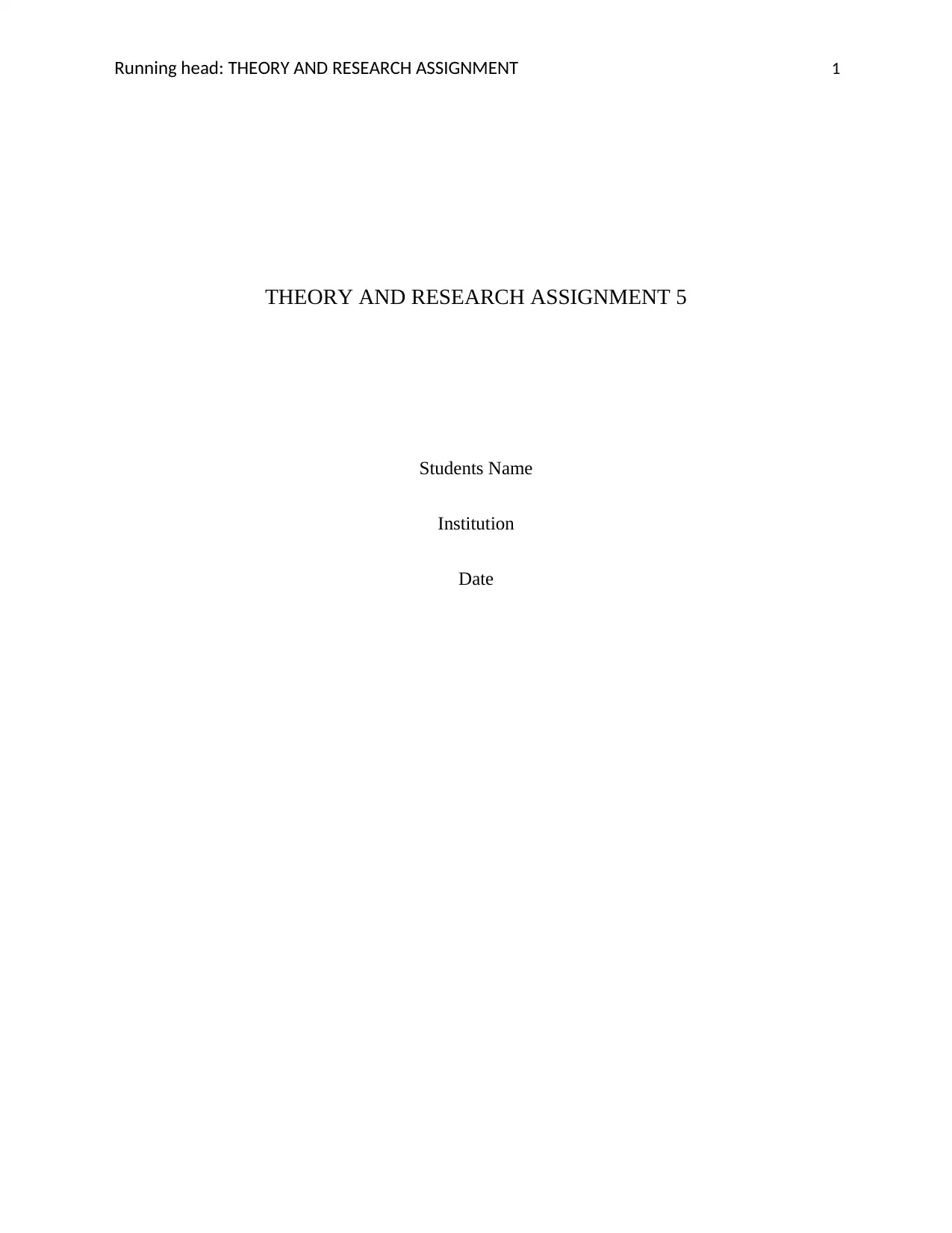
Running head: THEORY AND RESEARCH ASSIGNMENT 1
THEORY AND RESEARCH ASSIGNMENT 5
Students Name
Institution
Date
THEORY AND RESEARCH ASSIGNMENT 5
Students Name
Institution
Date
Paraphrase This Document
Need a fresh take? Get an instant paraphrase of this document with our AI Paraphraser
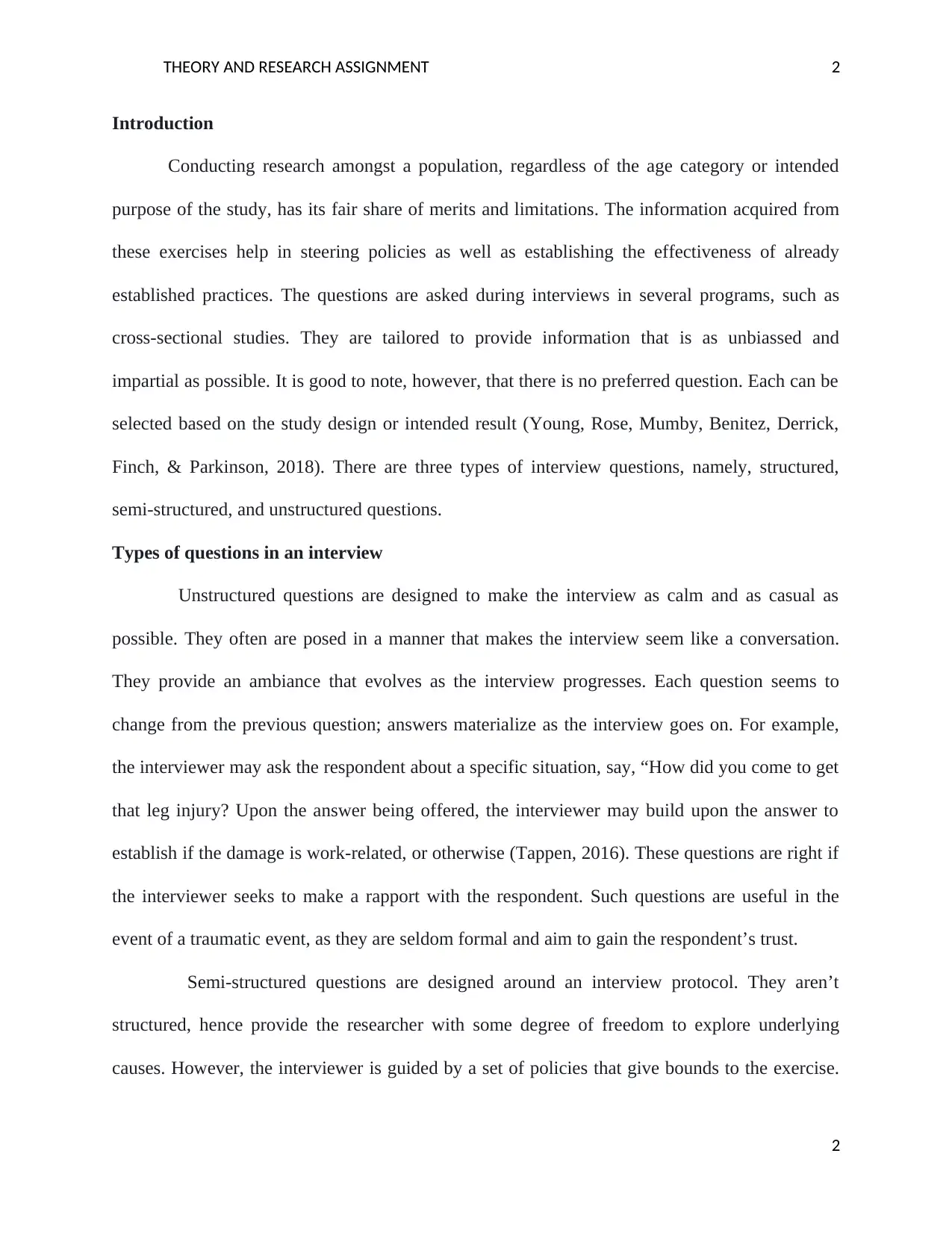
THEORY AND RESEARCH ASSIGNMENT 2
Introduction
Conducting research amongst a population, regardless of the age category or intended
purpose of the study, has its fair share of merits and limitations. The information acquired from
these exercises help in steering policies as well as establishing the effectiveness of already
established practices. The questions are asked during interviews in several programs, such as
cross-sectional studies. They are tailored to provide information that is as unbiassed and
impartial as possible. It is good to note, however, that there is no preferred question. Each can be
selected based on the study design or intended result (Young, Rose, Mumby, Benitez, Derrick,
Finch, & Parkinson, 2018). There are three types of interview questions, namely, structured,
semi-structured, and unstructured questions.
Types of questions in an interview
Unstructured questions are designed to make the interview as calm and as casual as
possible. They often are posed in a manner that makes the interview seem like a conversation.
They provide an ambiance that evolves as the interview progresses. Each question seems to
change from the previous question; answers materialize as the interview goes on. For example,
the interviewer may ask the respondent about a specific situation, say, “How did you come to get
that leg injury? Upon the answer being offered, the interviewer may build upon the answer to
establish if the damage is work-related, or otherwise (Tappen, 2016). These questions are right if
the interviewer seeks to make a rapport with the respondent. Such questions are useful in the
event of a traumatic event, as they are seldom formal and aim to gain the respondent’s trust.
Semi-structured questions are designed around an interview protocol. They aren’t
structured, hence provide the researcher with some degree of freedom to explore underlying
causes. However, the interviewer is guided by a set of policies that give bounds to the exercise.
2
Introduction
Conducting research amongst a population, regardless of the age category or intended
purpose of the study, has its fair share of merits and limitations. The information acquired from
these exercises help in steering policies as well as establishing the effectiveness of already
established practices. The questions are asked during interviews in several programs, such as
cross-sectional studies. They are tailored to provide information that is as unbiassed and
impartial as possible. It is good to note, however, that there is no preferred question. Each can be
selected based on the study design or intended result (Young, Rose, Mumby, Benitez, Derrick,
Finch, & Parkinson, 2018). There are three types of interview questions, namely, structured,
semi-structured, and unstructured questions.
Types of questions in an interview
Unstructured questions are designed to make the interview as calm and as casual as
possible. They often are posed in a manner that makes the interview seem like a conversation.
They provide an ambiance that evolves as the interview progresses. Each question seems to
change from the previous question; answers materialize as the interview goes on. For example,
the interviewer may ask the respondent about a specific situation, say, “How did you come to get
that leg injury? Upon the answer being offered, the interviewer may build upon the answer to
establish if the damage is work-related, or otherwise (Tappen, 2016). These questions are right if
the interviewer seeks to make a rapport with the respondent. Such questions are useful in the
event of a traumatic event, as they are seldom formal and aim to gain the respondent’s trust.
Semi-structured questions are designed around an interview protocol. They aren’t
structured, hence provide the researcher with some degree of freedom to explore underlying
causes. However, the interviewer is guided by a set of policies that give bounds to the exercise.
2
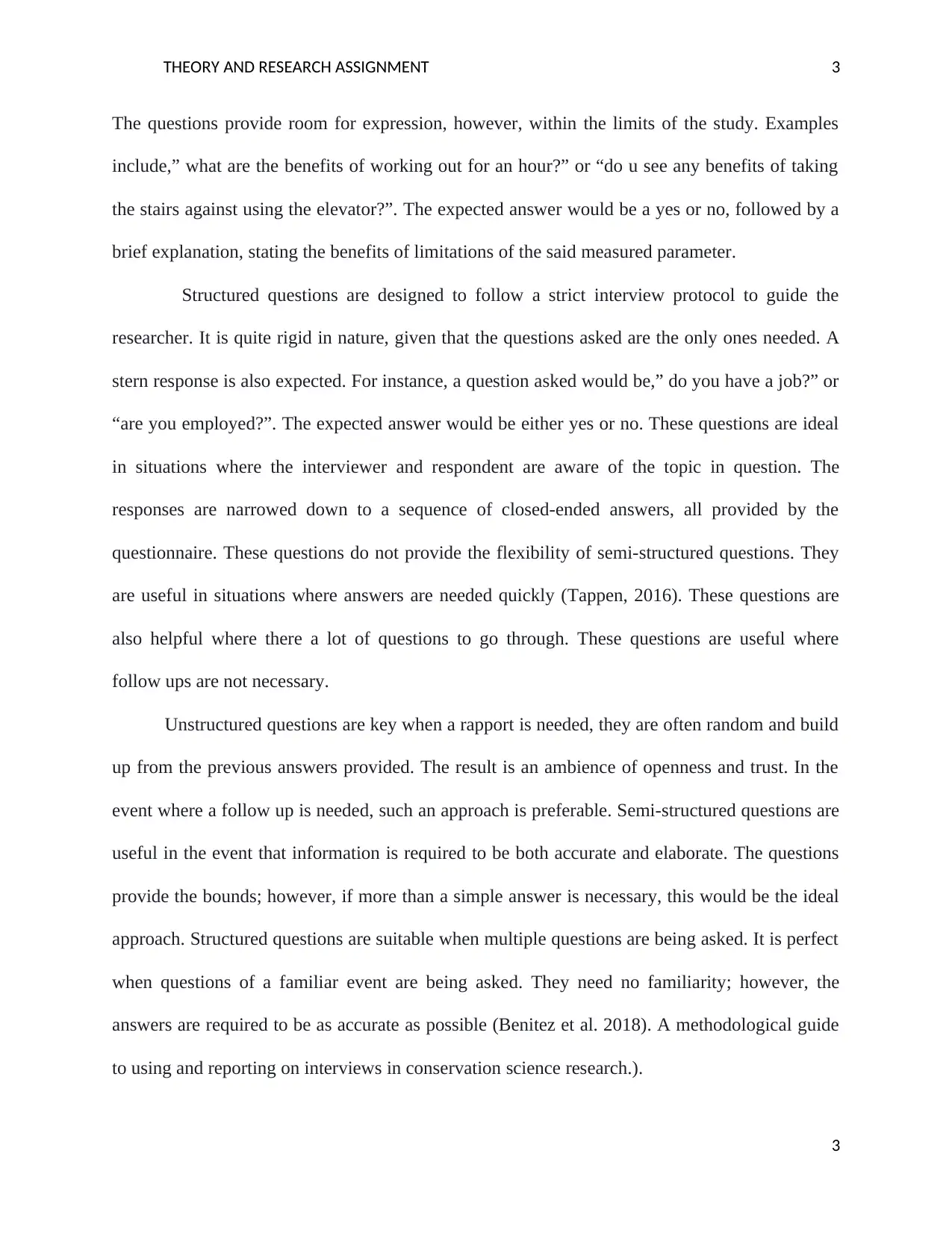
THEORY AND RESEARCH ASSIGNMENT 3
The questions provide room for expression, however, within the limits of the study. Examples
include,” what are the benefits of working out for an hour?” or “do u see any benefits of taking
the stairs against using the elevator?”. The expected answer would be a yes or no, followed by a
brief explanation, stating the benefits of limitations of the said measured parameter.
Structured questions are designed to follow a strict interview protocol to guide the
researcher. It is quite rigid in nature, given that the questions asked are the only ones needed. A
stern response is also expected. For instance, a question asked would be,” do you have a job?” or
“are you employed?”. The expected answer would be either yes or no. These questions are ideal
in situations where the interviewer and respondent are aware of the topic in question. The
responses are narrowed down to a sequence of closed-ended answers, all provided by the
questionnaire. These questions do not provide the flexibility of semi-structured questions. They
are useful in situations where answers are needed quickly (Tappen, 2016). These questions are
also helpful where there a lot of questions to go through. These questions are useful where
follow ups are not necessary.
Unstructured questions are key when a rapport is needed, they are often random and build
up from the previous answers provided. The result is an ambience of openness and trust. In the
event where a follow up is needed, such an approach is preferable. Semi-structured questions are
useful in the event that information is required to be both accurate and elaborate. The questions
provide the bounds; however, if more than a simple answer is necessary, this would be the ideal
approach. Structured questions are suitable when multiple questions are being asked. It is perfect
when questions of a familiar event are being asked. They need no familiarity; however, the
answers are required to be as accurate as possible (Benitez et al. 2018). A methodological guide
to using and reporting on interviews in conservation science research.).
3
The questions provide room for expression, however, within the limits of the study. Examples
include,” what are the benefits of working out for an hour?” or “do u see any benefits of taking
the stairs against using the elevator?”. The expected answer would be a yes or no, followed by a
brief explanation, stating the benefits of limitations of the said measured parameter.
Structured questions are designed to follow a strict interview protocol to guide the
researcher. It is quite rigid in nature, given that the questions asked are the only ones needed. A
stern response is also expected. For instance, a question asked would be,” do you have a job?” or
“are you employed?”. The expected answer would be either yes or no. These questions are ideal
in situations where the interviewer and respondent are aware of the topic in question. The
responses are narrowed down to a sequence of closed-ended answers, all provided by the
questionnaire. These questions do not provide the flexibility of semi-structured questions. They
are useful in situations where answers are needed quickly (Tappen, 2016). These questions are
also helpful where there a lot of questions to go through. These questions are useful where
follow ups are not necessary.
Unstructured questions are key when a rapport is needed, they are often random and build
up from the previous answers provided. The result is an ambience of openness and trust. In the
event where a follow up is needed, such an approach is preferable. Semi-structured questions are
useful in the event that information is required to be both accurate and elaborate. The questions
provide the bounds; however, if more than a simple answer is necessary, this would be the ideal
approach. Structured questions are suitable when multiple questions are being asked. It is perfect
when questions of a familiar event are being asked. They need no familiarity; however, the
answers are required to be as accurate as possible (Benitez et al. 2018). A methodological guide
to using and reporting on interviews in conservation science research.).
3
⊘ This is a preview!⊘
Do you want full access?
Subscribe today to unlock all pages.

Trusted by 1+ million students worldwide
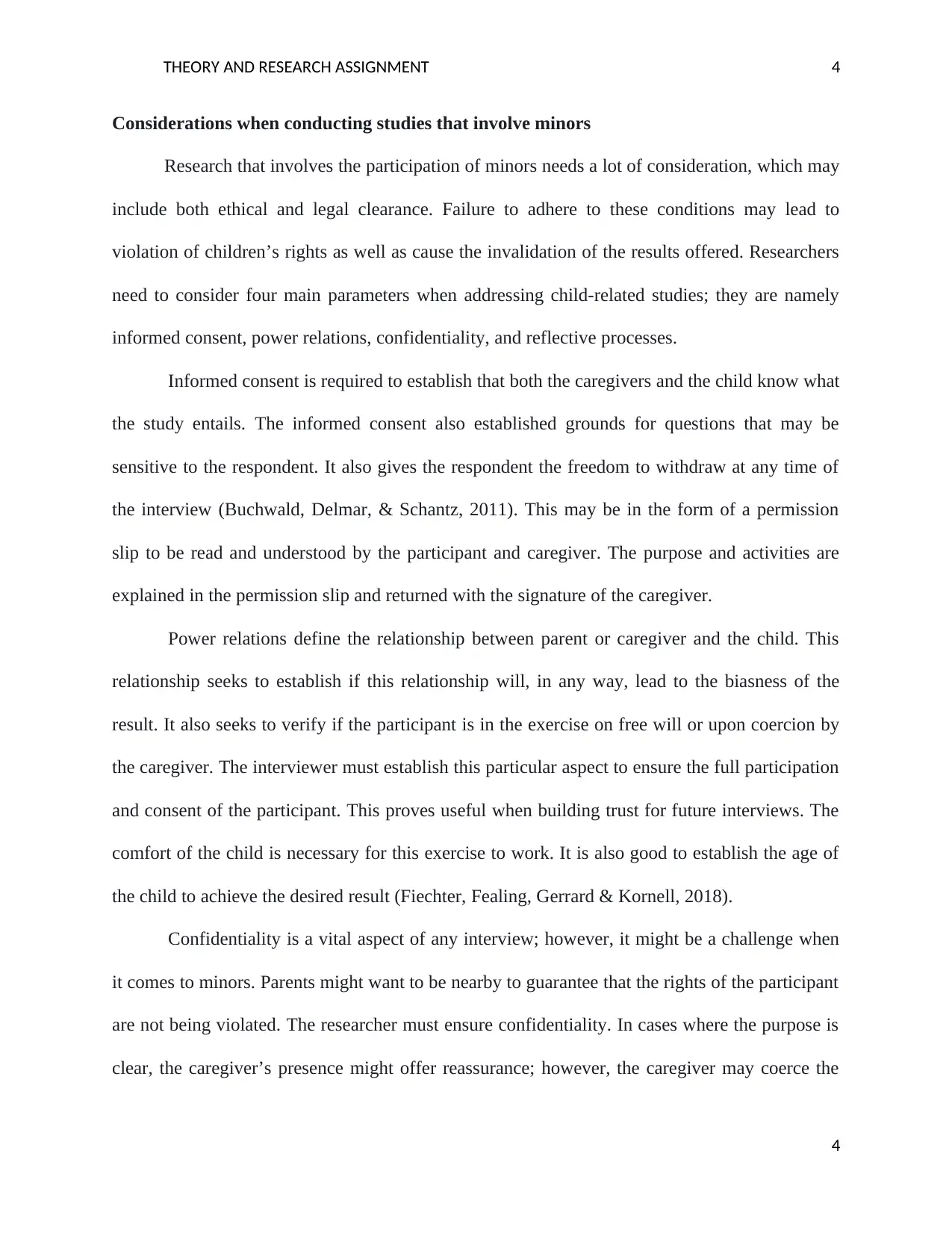
THEORY AND RESEARCH ASSIGNMENT 4
Considerations when conducting studies that involve minors
Research that involves the participation of minors needs a lot of consideration, which may
include both ethical and legal clearance. Failure to adhere to these conditions may lead to
violation of children’s rights as well as cause the invalidation of the results offered. Researchers
need to consider four main parameters when addressing child-related studies; they are namely
informed consent, power relations, confidentiality, and reflective processes.
Informed consent is required to establish that both the caregivers and the child know what
the study entails. The informed consent also established grounds for questions that may be
sensitive to the respondent. It also gives the respondent the freedom to withdraw at any time of
the interview (Buchwald, Delmar, & Schantz, 2011). This may be in the form of a permission
slip to be read and understood by the participant and caregiver. The purpose and activities are
explained in the permission slip and returned with the signature of the caregiver.
Power relations define the relationship between parent or caregiver and the child. This
relationship seeks to establish if this relationship will, in any way, lead to the biasness of the
result. It also seeks to verify if the participant is in the exercise on free will or upon coercion by
the caregiver. The interviewer must establish this particular aspect to ensure the full participation
and consent of the participant. This proves useful when building trust for future interviews. The
comfort of the child is necessary for this exercise to work. It is also good to establish the age of
the child to achieve the desired result (Fiechter, Fealing, Gerrard & Kornell, 2018).
Confidentiality is a vital aspect of any interview; however, it might be a challenge when
it comes to minors. Parents might want to be nearby to guarantee that the rights of the participant
are not being violated. The researcher must ensure confidentiality. In cases where the purpose is
clear, the caregiver’s presence might offer reassurance; however, the caregiver may coerce the
4
Considerations when conducting studies that involve minors
Research that involves the participation of minors needs a lot of consideration, which may
include both ethical and legal clearance. Failure to adhere to these conditions may lead to
violation of children’s rights as well as cause the invalidation of the results offered. Researchers
need to consider four main parameters when addressing child-related studies; they are namely
informed consent, power relations, confidentiality, and reflective processes.
Informed consent is required to establish that both the caregivers and the child know what
the study entails. The informed consent also established grounds for questions that may be
sensitive to the respondent. It also gives the respondent the freedom to withdraw at any time of
the interview (Buchwald, Delmar, & Schantz, 2011). This may be in the form of a permission
slip to be read and understood by the participant and caregiver. The purpose and activities are
explained in the permission slip and returned with the signature of the caregiver.
Power relations define the relationship between parent or caregiver and the child. This
relationship seeks to establish if this relationship will, in any way, lead to the biasness of the
result. It also seeks to verify if the participant is in the exercise on free will or upon coercion by
the caregiver. The interviewer must establish this particular aspect to ensure the full participation
and consent of the participant. This proves useful when building trust for future interviews. The
comfort of the child is necessary for this exercise to work. It is also good to establish the age of
the child to achieve the desired result (Fiechter, Fealing, Gerrard & Kornell, 2018).
Confidentiality is a vital aspect of any interview; however, it might be a challenge when
it comes to minors. Parents might want to be nearby to guarantee that the rights of the participant
are not being violated. The researcher must ensure confidentiality. In cases where the purpose is
clear, the caregiver’s presence might offer reassurance; however, the caregiver may coerce the
4
Paraphrase This Document
Need a fresh take? Get an instant paraphrase of this document with our AI Paraphraser
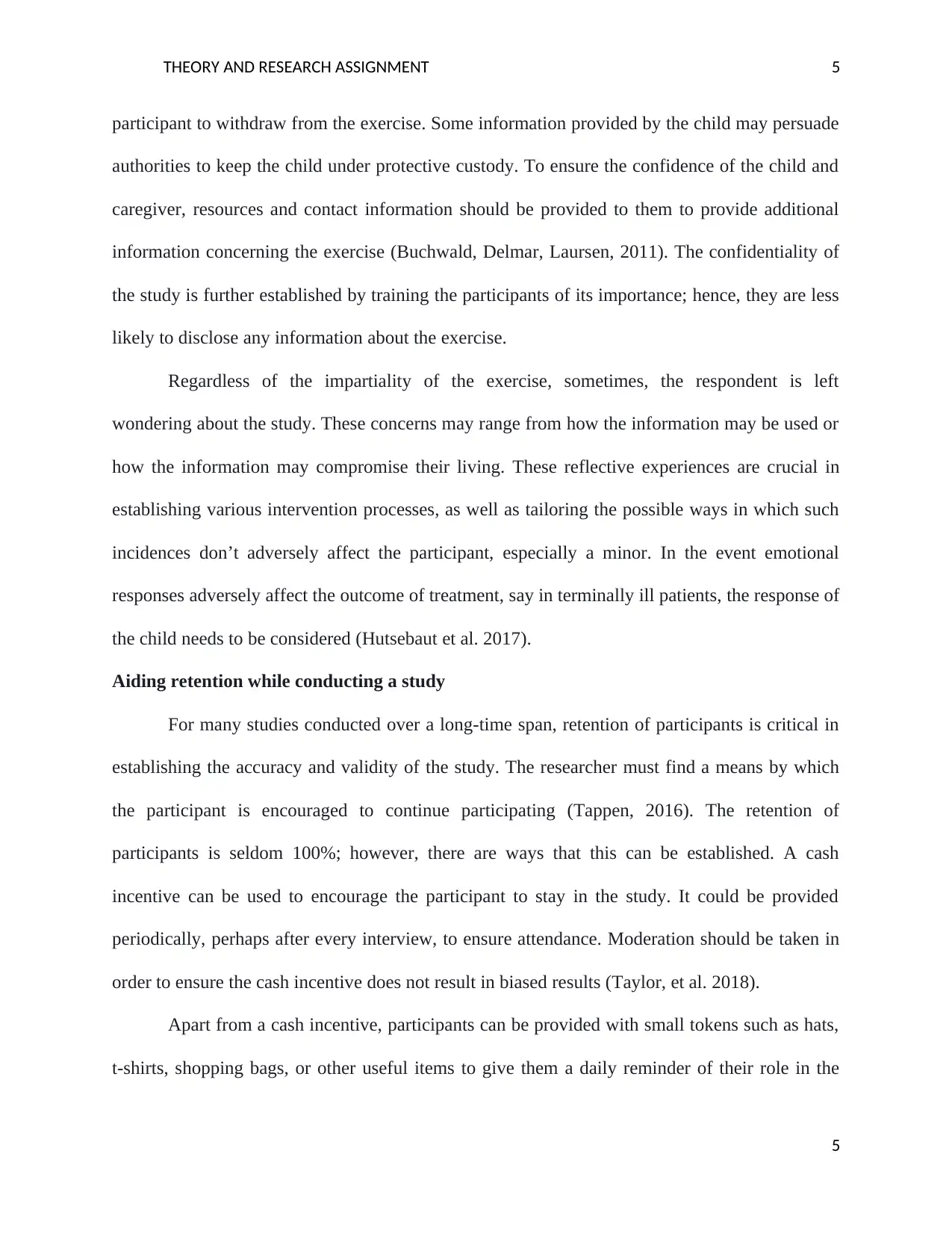
THEORY AND RESEARCH ASSIGNMENT 5
participant to withdraw from the exercise. Some information provided by the child may persuade
authorities to keep the child under protective custody. To ensure the confidence of the child and
caregiver, resources and contact information should be provided to them to provide additional
information concerning the exercise (Buchwald, Delmar, Laursen, 2011). The confidentiality of
the study is further established by training the participants of its importance; hence, they are less
likely to disclose any information about the exercise.
Regardless of the impartiality of the exercise, sometimes, the respondent is left
wondering about the study. These concerns may range from how the information may be used or
how the information may compromise their living. These reflective experiences are crucial in
establishing various intervention processes, as well as tailoring the possible ways in which such
incidences don’t adversely affect the participant, especially a minor. In the event emotional
responses adversely affect the outcome of treatment, say in terminally ill patients, the response of
the child needs to be considered (Hutsebaut et al. 2017).
Aiding retention while conducting a study
For many studies conducted over a long-time span, retention of participants is critical in
establishing the accuracy and validity of the study. The researcher must find a means by which
the participant is encouraged to continue participating (Tappen, 2016). The retention of
participants is seldom 100%; however, there are ways that this can be established. A cash
incentive can be used to encourage the participant to stay in the study. It could be provided
periodically, perhaps after every interview, to ensure attendance. Moderation should be taken in
order to ensure the cash incentive does not result in biased results (Taylor, et al. 2018).
Apart from a cash incentive, participants can be provided with small tokens such as hats,
t-shirts, shopping bags, or other useful items to give them a daily reminder of their role in the
5
participant to withdraw from the exercise. Some information provided by the child may persuade
authorities to keep the child under protective custody. To ensure the confidence of the child and
caregiver, resources and contact information should be provided to them to provide additional
information concerning the exercise (Buchwald, Delmar, Laursen, 2011). The confidentiality of
the study is further established by training the participants of its importance; hence, they are less
likely to disclose any information about the exercise.
Regardless of the impartiality of the exercise, sometimes, the respondent is left
wondering about the study. These concerns may range from how the information may be used or
how the information may compromise their living. These reflective experiences are crucial in
establishing various intervention processes, as well as tailoring the possible ways in which such
incidences don’t adversely affect the participant, especially a minor. In the event emotional
responses adversely affect the outcome of treatment, say in terminally ill patients, the response of
the child needs to be considered (Hutsebaut et al. 2017).
Aiding retention while conducting a study
For many studies conducted over a long-time span, retention of participants is critical in
establishing the accuracy and validity of the study. The researcher must find a means by which
the participant is encouraged to continue participating (Tappen, 2016). The retention of
participants is seldom 100%; however, there are ways that this can be established. A cash
incentive can be used to encourage the participant to stay in the study. It could be provided
periodically, perhaps after every interview, to ensure attendance. Moderation should be taken in
order to ensure the cash incentive does not result in biased results (Taylor, et al. 2018).
Apart from a cash incentive, participants can be provided with small tokens such as hats,
t-shirts, shopping bags, or other useful items to give them a daily reminder of their role in the
5
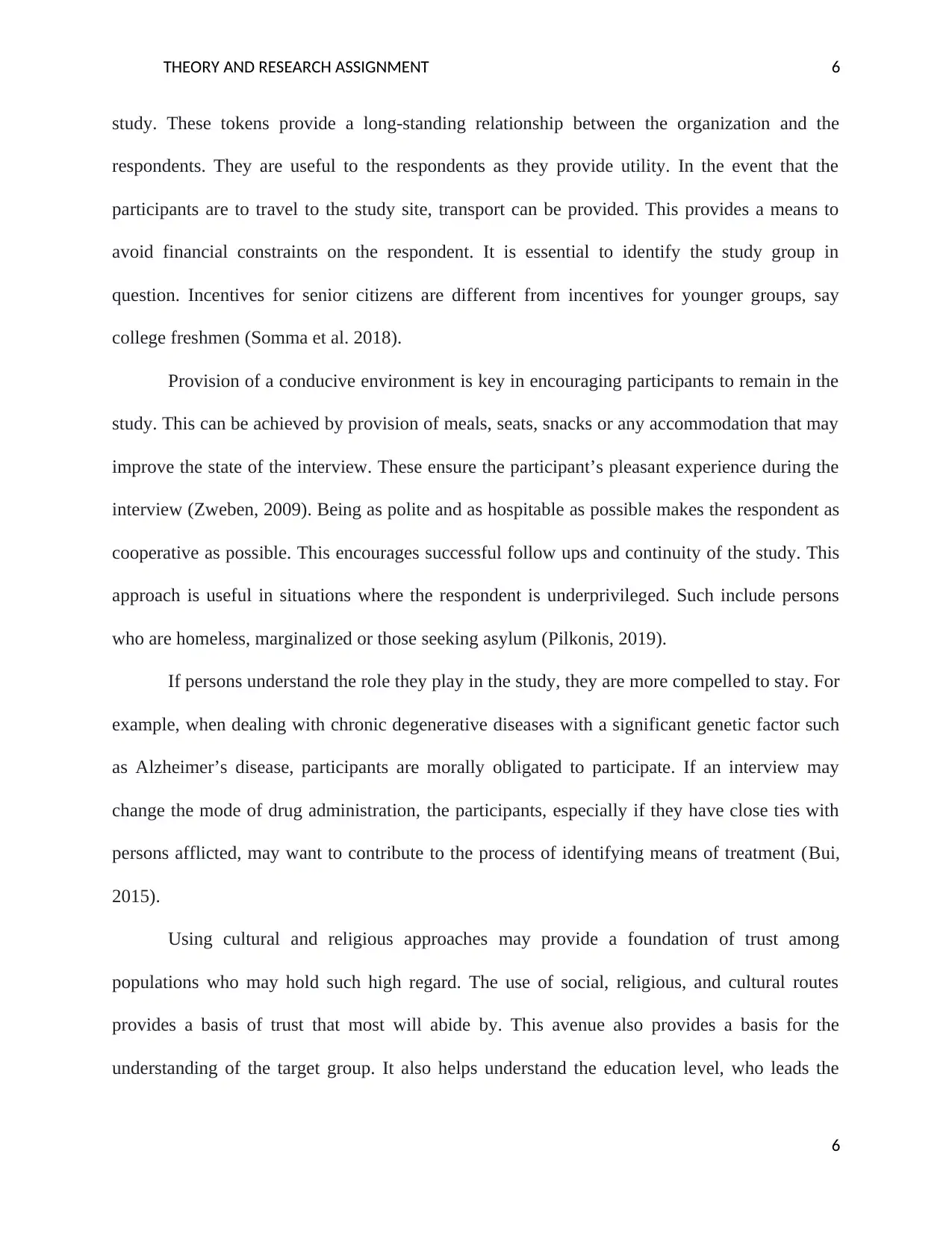
THEORY AND RESEARCH ASSIGNMENT 6
study. These tokens provide a long-standing relationship between the organization and the
respondents. They are useful to the respondents as they provide utility. In the event that the
participants are to travel to the study site, transport can be provided. This provides a means to
avoid financial constraints on the respondent. It is essential to identify the study group in
question. Incentives for senior citizens are different from incentives for younger groups, say
college freshmen (Somma et al. 2018).
Provision of a conducive environment is key in encouraging participants to remain in the
study. This can be achieved by provision of meals, seats, snacks or any accommodation that may
improve the state of the interview. These ensure the participant’s pleasant experience during the
interview (Zweben, 2009). Being as polite and as hospitable as possible makes the respondent as
cooperative as possible. This encourages successful follow ups and continuity of the study. This
approach is useful in situations where the respondent is underprivileged. Such include persons
who are homeless, marginalized or those seeking asylum (Pilkonis, 2019).
If persons understand the role they play in the study, they are more compelled to stay. For
example, when dealing with chronic degenerative diseases with a significant genetic factor such
as Alzheimer’s disease, participants are morally obligated to participate. If an interview may
change the mode of drug administration, the participants, especially if they have close ties with
persons afflicted, may want to contribute to the process of identifying means of treatment (Bui,
2015).
Using cultural and religious approaches may provide a foundation of trust among
populations who may hold such high regard. The use of social, religious, and cultural routes
provides a basis of trust that most will abide by. This avenue also provides a basis for the
understanding of the target group. It also helps understand the education level, who leads the
6
study. These tokens provide a long-standing relationship between the organization and the
respondents. They are useful to the respondents as they provide utility. In the event that the
participants are to travel to the study site, transport can be provided. This provides a means to
avoid financial constraints on the respondent. It is essential to identify the study group in
question. Incentives for senior citizens are different from incentives for younger groups, say
college freshmen (Somma et al. 2018).
Provision of a conducive environment is key in encouraging participants to remain in the
study. This can be achieved by provision of meals, seats, snacks or any accommodation that may
improve the state of the interview. These ensure the participant’s pleasant experience during the
interview (Zweben, 2009). Being as polite and as hospitable as possible makes the respondent as
cooperative as possible. This encourages successful follow ups and continuity of the study. This
approach is useful in situations where the respondent is underprivileged. Such include persons
who are homeless, marginalized or those seeking asylum (Pilkonis, 2019).
If persons understand the role they play in the study, they are more compelled to stay. For
example, when dealing with chronic degenerative diseases with a significant genetic factor such
as Alzheimer’s disease, participants are morally obligated to participate. If an interview may
change the mode of drug administration, the participants, especially if they have close ties with
persons afflicted, may want to contribute to the process of identifying means of treatment (Bui,
2015).
Using cultural and religious approaches may provide a foundation of trust among
populations who may hold such high regard. The use of social, religious, and cultural routes
provides a basis of trust that most will abide by. This avenue also provides a basis for the
understanding of the target group. It also helps understand the education level, who leads the
6
⊘ This is a preview!⊘
Do you want full access?
Subscribe today to unlock all pages.

Trusted by 1+ million students worldwide
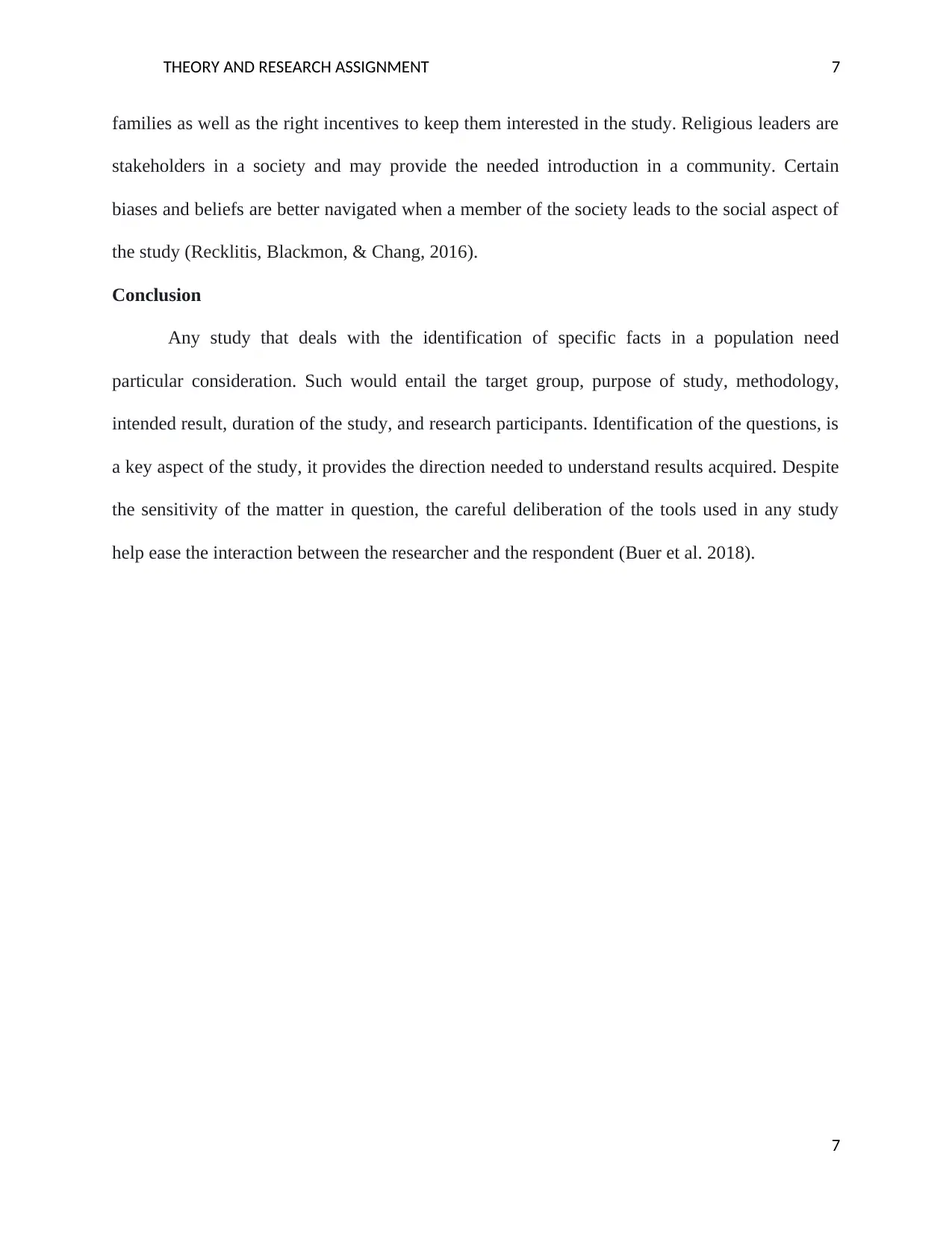
THEORY AND RESEARCH ASSIGNMENT 7
families as well as the right incentives to keep them interested in the study. Religious leaders are
stakeholders in a society and may provide the needed introduction in a community. Certain
biases and beliefs are better navigated when a member of the society leads to the social aspect of
the study (Recklitis, Blackmon, & Chang, 2016).
Conclusion
Any study that deals with the identification of specific facts in a population need
particular consideration. Such would entail the target group, purpose of study, methodology,
intended result, duration of the study, and research participants. Identification of the questions, is
a key aspect of the study, it provides the direction needed to understand results acquired. Despite
the sensitivity of the matter in question, the careful deliberation of the tools used in any study
help ease the interaction between the researcher and the respondent (Buer et al. 2018).
7
families as well as the right incentives to keep them interested in the study. Religious leaders are
stakeholders in a society and may provide the needed introduction in a community. Certain
biases and beliefs are better navigated when a member of the society leads to the social aspect of
the study (Recklitis, Blackmon, & Chang, 2016).
Conclusion
Any study that deals with the identification of specific facts in a population need
particular consideration. Such would entail the target group, purpose of study, methodology,
intended result, duration of the study, and research participants. Identification of the questions, is
a key aspect of the study, it provides the direction needed to understand results acquired. Despite
the sensitivity of the matter in question, the careful deliberation of the tools used in any study
help ease the interaction between the researcher and the respondent (Buer et al. 2018).
7
Paraphrase This Document
Need a fresh take? Get an instant paraphrase of this document with our AI Paraphraser
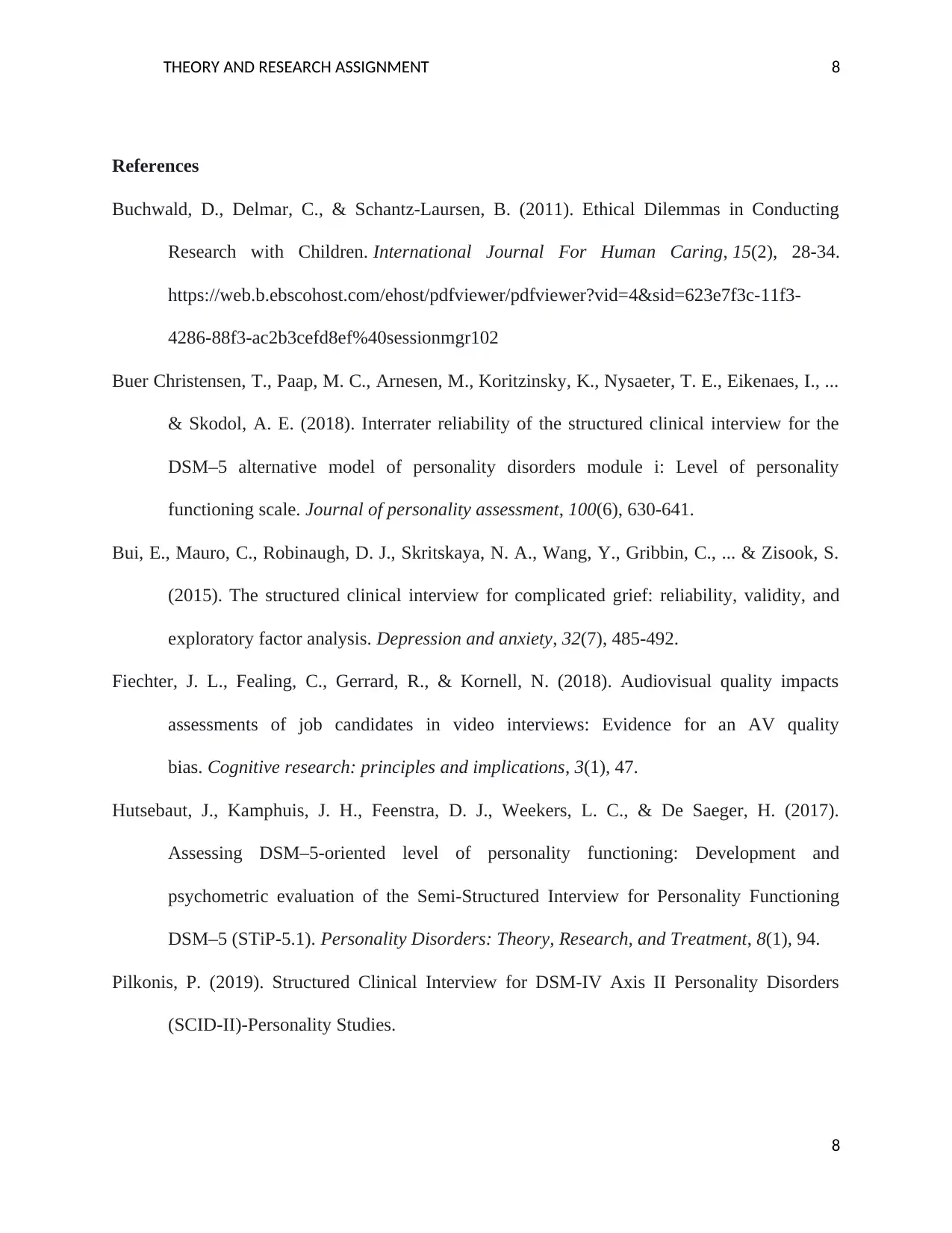
THEORY AND RESEARCH ASSIGNMENT 8
References
Buchwald, D., Delmar, C., & Schantz-Laursen, B. (2011). Ethical Dilemmas in Conducting
Research with Children. International Journal For Human Caring, 15(2), 28-34.
https://web.b.ebscohost.com/ehost/pdfviewer/pdfviewer?vid=4&sid=623e7f3c-11f3-
4286-88f3-ac2b3cefd8ef%40sessionmgr102
Buer Christensen, T., Paap, M. C., Arnesen, M., Koritzinsky, K., Nysaeter, T. E., Eikenaes, I., ...
& Skodol, A. E. (2018). Interrater reliability of the structured clinical interview for the
DSM–5 alternative model of personality disorders module i: Level of personality
functioning scale. Journal of personality assessment, 100(6), 630-641.
Bui, E., Mauro, C., Robinaugh, D. J., Skritskaya, N. A., Wang, Y., Gribbin, C., ... & Zisook, S.
(2015). The structured clinical interview for complicated grief: reliability, validity, and
exploratory factor analysis. Depression and anxiety, 32(7), 485-492.
Fiechter, J. L., Fealing, C., Gerrard, R., & Kornell, N. (2018). Audiovisual quality impacts
assessments of job candidates in video interviews: Evidence for an AV quality
bias. Cognitive research: principles and implications, 3(1), 47.
Hutsebaut, J., Kamphuis, J. H., Feenstra, D. J., Weekers, L. C., & De Saeger, H. (2017).
Assessing DSM–5-oriented level of personality functioning: Development and
psychometric evaluation of the Semi-Structured Interview for Personality Functioning
DSM–5 (STiP-5.1). Personality Disorders: Theory, Research, and Treatment, 8(1), 94.
Pilkonis, P. (2019). Structured Clinical Interview for DSM-IV Axis II Personality Disorders
(SCID-II)-Personality Studies.
8
References
Buchwald, D., Delmar, C., & Schantz-Laursen, B. (2011). Ethical Dilemmas in Conducting
Research with Children. International Journal For Human Caring, 15(2), 28-34.
https://web.b.ebscohost.com/ehost/pdfviewer/pdfviewer?vid=4&sid=623e7f3c-11f3-
4286-88f3-ac2b3cefd8ef%40sessionmgr102
Buer Christensen, T., Paap, M. C., Arnesen, M., Koritzinsky, K., Nysaeter, T. E., Eikenaes, I., ...
& Skodol, A. E. (2018). Interrater reliability of the structured clinical interview for the
DSM–5 alternative model of personality disorders module i: Level of personality
functioning scale. Journal of personality assessment, 100(6), 630-641.
Bui, E., Mauro, C., Robinaugh, D. J., Skritskaya, N. A., Wang, Y., Gribbin, C., ... & Zisook, S.
(2015). The structured clinical interview for complicated grief: reliability, validity, and
exploratory factor analysis. Depression and anxiety, 32(7), 485-492.
Fiechter, J. L., Fealing, C., Gerrard, R., & Kornell, N. (2018). Audiovisual quality impacts
assessments of job candidates in video interviews: Evidence for an AV quality
bias. Cognitive research: principles and implications, 3(1), 47.
Hutsebaut, J., Kamphuis, J. H., Feenstra, D. J., Weekers, L. C., & De Saeger, H. (2017).
Assessing DSM–5-oriented level of personality functioning: Development and
psychometric evaluation of the Semi-Structured Interview for Personality Functioning
DSM–5 (STiP-5.1). Personality Disorders: Theory, Research, and Treatment, 8(1), 94.
Pilkonis, P. (2019). Structured Clinical Interview for DSM-IV Axis II Personality Disorders
(SCID-II)-Personality Studies.
8

THEORY AND RESEARCH ASSIGNMENT 9
Recklitis, C. J., Blackmon, J. E., & Chang, G. (2016). Screening young adult cancer survivors for
distress with the distress thermometer: comparisons with a structured clinical diagnostic
interview. Cancer, 122(2), 296-303.
Somma, A., Carlotta, D., Boni, F., Arlotta, E., Masci, E., Busso, S., ... & Fossati, A. (2019).
Reliability and validity of the Structured Clinical Interview for DSM-5-Clinician Version
(SCID-5-CV) Attention Deficit/Hyperactivity Disorder Criteria: preliminary evidence
from a sample of 217 Italian adolescents. Cited in: EMBASE-Excerpta Medica Database•
Index Copernicus• PsycINFO• SCOPUS• Google Scholar• Emerging Sources Citation
Index (ESCI), a new edition of Web of Science, 3.
Tappen, R. (2016). Advanced nursing research: From theory to practice (2nd ed.). Sudbury,
MA: Jones and Bartlett.
Taylor, D. J., Wilkerson, A. K., Pruiksma, K. E., Williams, J. M., Ruggero, C. J., Hale, W., ... &
Young-McCaughan, S. (2018). Reliability of the structured clinical interview for DSM-5
sleep disorders module. Journal of Clinical Sleep Medicine, 14(03), 459-464.
Young, J. C., Rose, D. C., Mumby, H. S., Benitez‐Capistros, F., Derrick, C. J., Finch, T., ... &
Parkinson, S. (2018). A methodological guide to using and reporting on interviews in
conservation science research. Methods in Ecology and Evolution, 9(1), 10-19.
Zweben, A. (2009). Effective Strategies for Maintaining Research Participation in Clinical
Trials. Drug Inf, J.,43(4). doi:10.1177/009286150904300411
9
Recklitis, C. J., Blackmon, J. E., & Chang, G. (2016). Screening young adult cancer survivors for
distress with the distress thermometer: comparisons with a structured clinical diagnostic
interview. Cancer, 122(2), 296-303.
Somma, A., Carlotta, D., Boni, F., Arlotta, E., Masci, E., Busso, S., ... & Fossati, A. (2019).
Reliability and validity of the Structured Clinical Interview for DSM-5-Clinician Version
(SCID-5-CV) Attention Deficit/Hyperactivity Disorder Criteria: preliminary evidence
from a sample of 217 Italian adolescents. Cited in: EMBASE-Excerpta Medica Database•
Index Copernicus• PsycINFO• SCOPUS• Google Scholar• Emerging Sources Citation
Index (ESCI), a new edition of Web of Science, 3.
Tappen, R. (2016). Advanced nursing research: From theory to practice (2nd ed.). Sudbury,
MA: Jones and Bartlett.
Taylor, D. J., Wilkerson, A. K., Pruiksma, K. E., Williams, J. M., Ruggero, C. J., Hale, W., ... &
Young-McCaughan, S. (2018). Reliability of the structured clinical interview for DSM-5
sleep disorders module. Journal of Clinical Sleep Medicine, 14(03), 459-464.
Young, J. C., Rose, D. C., Mumby, H. S., Benitez‐Capistros, F., Derrick, C. J., Finch, T., ... &
Parkinson, S. (2018). A methodological guide to using and reporting on interviews in
conservation science research. Methods in Ecology and Evolution, 9(1), 10-19.
Zweben, A. (2009). Effective Strategies for Maintaining Research Participation in Clinical
Trials. Drug Inf, J.,43(4). doi:10.1177/009286150904300411
9
⊘ This is a preview!⊘
Do you want full access?
Subscribe today to unlock all pages.

Trusted by 1+ million students worldwide
1 out of 9
Related Documents
Your All-in-One AI-Powered Toolkit for Academic Success.
+13062052269
info@desklib.com
Available 24*7 on WhatsApp / Email
![[object Object]](/_next/static/media/star-bottom.7253800d.svg)
Unlock your academic potential
Copyright © 2020–2025 A2Z Services. All Rights Reserved. Developed and managed by ZUCOL.





